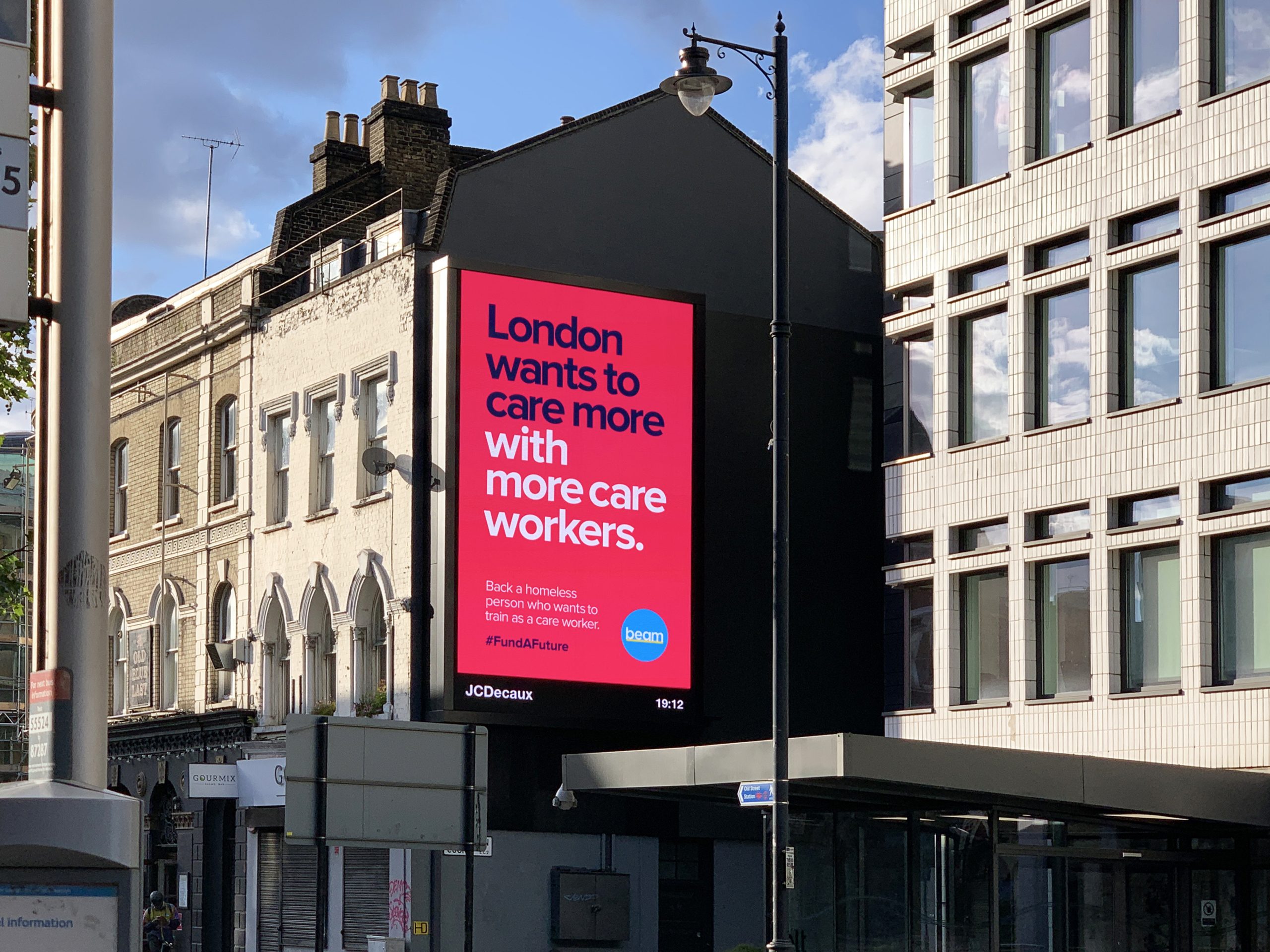 637
637  6 mins
6 mins An innovative homeless crowdfunding platform is helping people find new jobs and homes, and a bright new future.
Alex Stephany has thought long and hard about the circumstances that drive people towards homelessness (1).
Back in 2016, he would regularly come across a man living homeless at his local tube station.
They eventually became friends.
Stephany tried to help, buying him things like coffee and socks.
But he really wanted to help his friend out of his situation and he felt powerless to do more.
Having a background in tech, he started to question how he could apply his skills in technology to help people living homeless.
Stephany knew that some people were simply more at risk than others.
Likewise, he realised that the long-term solution for many meant developing something that he calls “scaffolding.”
“Scaffolding consists of two things: training and education – which creates economic opportunity – and support networks,” Stephany explains. “It could be the answer to helping people get the chance to “sustainably support themselves.”
Meanwhile, Stephany continued his research.
He found that once the cycle of precarious living begins, it is tough to return to the workforce.
Frequently, the main barrier to breaking the cycle is initial funding.
Many people simply don’t have the savings to pay for skills training. Furthermore, they don’t have access to funding and getting a bank loan is not an option.
Therefore, it becomes impossible to pay for the most basic start-up costs such as work clothes or transportation as they wait for their first paycheck.
In searching for an answer to the problem, Stephany saw that many other people were willing to pitch in and help.
The idea of creating a crowdfunding platform was born.
View this post on Instagram
Homeless crowdfunding – inventing a solution
Stephany launched Beam in 2017 with backing from the Mayor of London and some of the UK’s leading tech entrepreneurs.
It is a groundbreaking social enterprise – the first of its kind.
Beam uses crowdfunding technology to raise money for people living homeless.
Their digital solution helps people break out of the cycle of precarity and begin a new life by giving people the scaffolding they need.
Members can reach a wide network of supporters and raise the money to return to work by covering costs such as tuition, textbooks, transport or childcare to allow the person to attend classes.
And this laser focus on covering start-up costs makes the campaigns relatable and easy to understand.
Sophia’s campaign
Sophia’s story is one of the almost 900 stories of people who have used Beam’s platform to help turn their lives in a different direction.
She began living homeless when her mum suddenly turned her out of the house.
In her campaign summary, she describes some of the personal details that added to the difficulties she faced.
She also talks about feeling frightened by living homeless while feeling hopeful and confident about the future.
When she launched her campaign, she explained, “My current goal for the next two years is to get into work as a warehouse operative, so I can find a place of my own.”
Sophia also wanted to get CompTIA certification, “So eventually I can find a job in the IT industry via support or front-end development.”
Sophia began working with Katie Dawson, a Beam Operations Executive, in the fall of 2020.
Her campaign began funding in September.
Sophia hoped to raise £1,556 to cover the costs of tuition, a laptop, one month’s travel expenses, safety boots for work and some contingency expenses.
Monetary contributions began to come in immediately, and Sophia worked on her CV.
Sophia’s campaign was fully funded in only 15 days. Sophia received 122 contributions ranging in size from £0.02 to £239.
Roughly half the contributions amounted to less than the price of a cup of coffee.
As a result, she began work as a warehouse operative in December 2020.
In an update posted to her campaign, she explained she was about to begin studying for her course to work towards her longer-term objective of finding a job in IT.
The bigger picture
People from all walks of life live in unstable housing.
The reasons may be transitional, episodic or chronic.
The UK charity Shelter recently reported 274,000 people without housing in England in December 2021.
It is an emergency of epic proportions.
Today, one in every 206 people in England is without a home, either sleeping rough, sleeping in emergency shelters and direct access hostels or in living temporary accommodations.
View this post on Instagram
Pandemic-related measures did provide temporary relief to some.
This is the case of the recent year-end £1,000 boost given to the 2 million lowest-income working households.
However, thousands now find themselves again at risk of losing their homes as these temporary measures end. This happened when the eviction ban was lifted in May 2021. Almost 5,000 renters in England and Wales were evicted from their homes.
Additionally, housing and living costs continue to rise from month to month, increasing the financial stress on low-income households.
A broken system
“Our broken housing market is one of the greatest barriers to progress in Britain today,” wrote the Most Honourable Teresa May in the 2017 whitepaper “Fixing our broken housing market.”
“Whether buying or renting, the fact is that housing is increasingly unaffordable – particularly for ordinary working-class people who are struggling to get by,” observed the former Prime Minister, prior to the economic stress caused by the pandemic.
“People who are homeless are not social inadequates.
They are people without homes.”
Dame Sheila McKechnie
In its follow-up report “Building and more social housing”, The House of Commons Housing, Communities and Local Government Committee evaluated the effectiveness of the government’s approach.
This pre-pandemic report found, “Last year (2018), less than 7,000 social rent homes were built, despite evidence that England needs around 90,000 more social rent homes a year for the next fifteen years.”
Similarly, the report also noted, “It is disappointing that the Government does not have a published plan on social housing, nor has its own assessment of social housing need.”
Given the seriousness of this situation, public services, charities and innovative social initiatives like Beam are filling a critical vacuum.

Beam’s Fund a Future Campaign #fundafuture (image courtesy of Beam)
Homeless crowdfunding – how it works
At the time of this writing, there were 27 Beam campaigns underway with people looking to raise amounts ranging from £700 to £4,000.
Beam reports that they have already helped 889 people to start new careers and find secure housing through crowdfunding.
The solution designed by Beam is deceptively simple.
Prospective members can be referred to Beam directly on their website.
Once referred, the member begins to work with an Operations Executive.
The member and Operations Executive begin a journey that will continue all the way to employment and a bit beyond.
Firstly, they create a campaign budget that includes items such as the cost of the training and other essentials like work clothes, transport and child care.
Then, they launch the member’s crowdfunding campaign online. The campaign includes the campaign budget, a picture of the member and most importantly, their story.
Once the campaign is launched, individuals and businesses donate money to the member and post messages of support online.
When the campaign funding objective is reached, Beam continues to support its members throughout their training period.
Operations Executives also help members search for post-training employment.
Homeless crowdfunding campaigns fund quickly.
Beam reports that 100% of the campaigns are fully funded in under 100 days.
A common theme through many of the members’ stories is the sense of hope they feel from seeing their campaign getting funded.
Many also describe the feelings of encouragement, belonging, and accountability that arose from seeing hundreds of anonymous strangers who believed in them, donated money and shared a message of encouragement.
Beam provided exactly the scaffolding they needed to take the next step forward on their journey.

Beam crowdfunding alumni Decoda, graduating with Level 3 Health & Social Care Diploma (image courtesy of Beam)
Why does it matter?
An inescapable consequence of the broken housing system combined with the pandemic is that many people are losing their homes.
Living homeless is always a tragedy.
It comes with stigma and countless health, social and economic inequities and risks.
Furthermore, it is a threat to physical and mental wellbeing.
“People who are homeless very often belong to the people furthest away from the labour market… integration into employment or occupational activities can play a key role in bringing a person who is homeless on a pathway out of poverty and social exclusion. It helps establish a social network, gaining experience, improving skills, developing self esteem and moving towards financial independence. This has a positive effect on other areas of life as well, such as the mental well being of the person” writes the European Federation of National Organisations working with the Homeless.
Homeless crowdfunding is an innovative approach, helping to solve a piece of a very complex problem.
More information
Four years after launching its first campaign, Beam has shown how homeless crowdfunding can help change many lives.
Visit their website to learn more. You will also find the stories of the people they have helped and the people who currently have campaigns underway.
Follow them on Instagram, Twitter, Facebook, LinkedIn or Youtube.
Can’t spare £1 per month to join as a monthly supporter?
You can still play a part by sending messages of encouragement to the people using the service or, of course, just by spreading the word.
To join Beam for free, visit beam.org
Or listen to Alex Stephany:
(1) The language around living unhoused is finally changing. The Inspirer has chosen to adopt the AP stylebook Guidelines and we use the word “homeless” in the broad sense, as defined by the Local Government Association in its report “The impact of homelessness on health – a guide for Local Authorities”.
The LGA definition: “Homelessness is: rooflessness (without a shelter of any kind, sleeping rough); houselessness (with a place to sleep but temporary in institutions or shelter); living in insecure housing (threatened with severe exclusion due to insecure tenancies, eviction, domestic violence); living in inadequate housing (in caravans on illegal campsites, in unfit housing, in extreme overcrowding).
Feature image credit: Martin Gammon (2019) courtesy of BEAM
If you enjoyed this article you might also be interested in how Lakshmi Menon embarked on journey to create decent bedding for people sleeping rough in India land and developed a circular economy solution now used in India’s Covid Front Line Treatment Centres.


 https://www.shutterstock.com/image-photo/glowing-kelp-526412359
https://www.shutterstock.com/image-photo/glowing-kelp-526412359 Quote This Woman+
Quote This Woman+